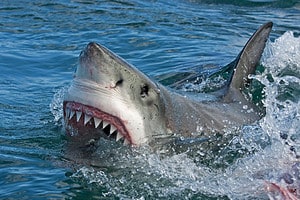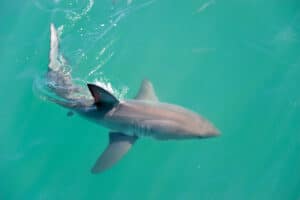Would you believe that there is a shark out there that lets you touch them? How about one that looks like a stingray? Believe it or not, the answer is yes, and yes — and these are just two of 13 harmless sharks that don’t pose a threat.
Sharks are often misunderstood and mislabeled, with people believing them to be bloodthirsty monsters. Every time a shark attack makes the headlines, we are left with images of merciless oceanic predators hunting down innocent people. The truth, however, is that even the most dangerous shark species rarely attack humans — and when they do, it’s usually an accident of mistaken identity. In fact, some harmless sharks can be so friendly they seem more like puppies than hunters!
So while they may not have an ideal reputation in our culture today, we owe it to ourselves (and the sharks) to look at things from a different perspective. These fabulous fish, with endless sets of replacement teeth, get a bad rap. But there are many sharks that never bite, chomp on, or attack people. They deserve to be talked about, so let’s get right to it!
1. Whale Shark (Rhincodon typus)
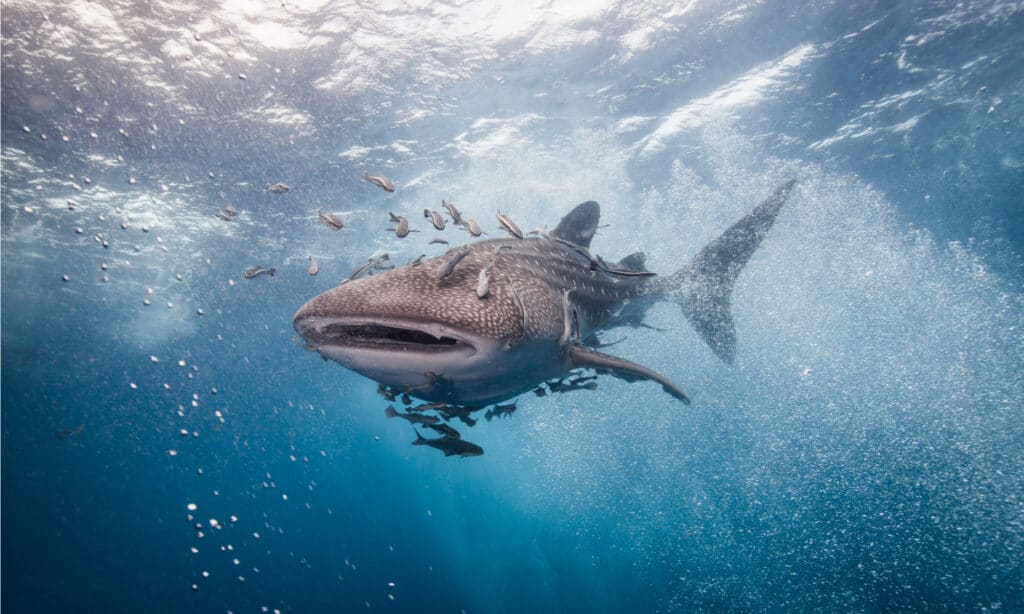
Whale shark swimming with pilot fish.
©Tee Wong/Shutterstock.com
The name usually stumps people: is it a whale or a shark? Whale sharks are not whales or mammals, despite their name. They are sharks, and their name comes from their enormous size. The whale shark is the largest fish in the world — it can grow up to 60 feet long and weigh up to 41,000 pounds!
Although this creature is ginormous, it is a harmless shark that poses no threat to humans. Whale sharks are filter feeders and only eat plankton and small fish — not humans. The irony of their story is that as gentle as they are towards human beings, they’re a threatened species because of humans, according to the IUCN. This is due to commercial and recreational fishing.
2. Leopard Shark (Triakis semifasciata)
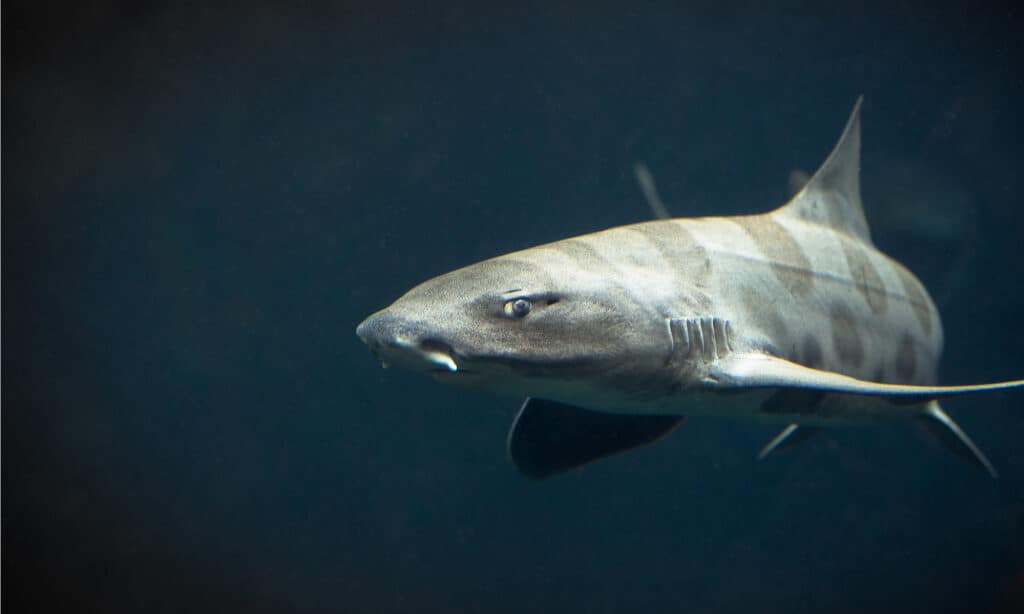
The
leopard
shark poses no threat to humans.
©evantravels/Shutterstock.com
Compared to the whale shark, the leopard shark looks like a baby! Measuring 4 to 6 feet long and weighing around 40 pounds, the leopard shark is fortunate that the whale shark eats mostly krill, shrimp, fish eggs, and small squid instead of small sharks.
Leopard sharks have exquisite patterns on their bodies with spots and saddle-type markings. They live in the Pacific Ocean and enjoy the sandy and muddy bottoms of bays. These gorgeous and harmless sharks hide on the sea floor, camouflaging themselves until unsuspecting prey swims by. They are rarely seen in the ocean at a depth of more than 65 feet.
Leopard sharks are social animals and usually travel in large schools. Although they live in shallow, coastal waters, they are not a threat to humans. Most of them stay in the same area for a large portion of their lives. While whale sharks have other snacks available, unfortunately, other large sharks, like the great white prey on leopard sharks.
3. Angel Shark (Squatina)
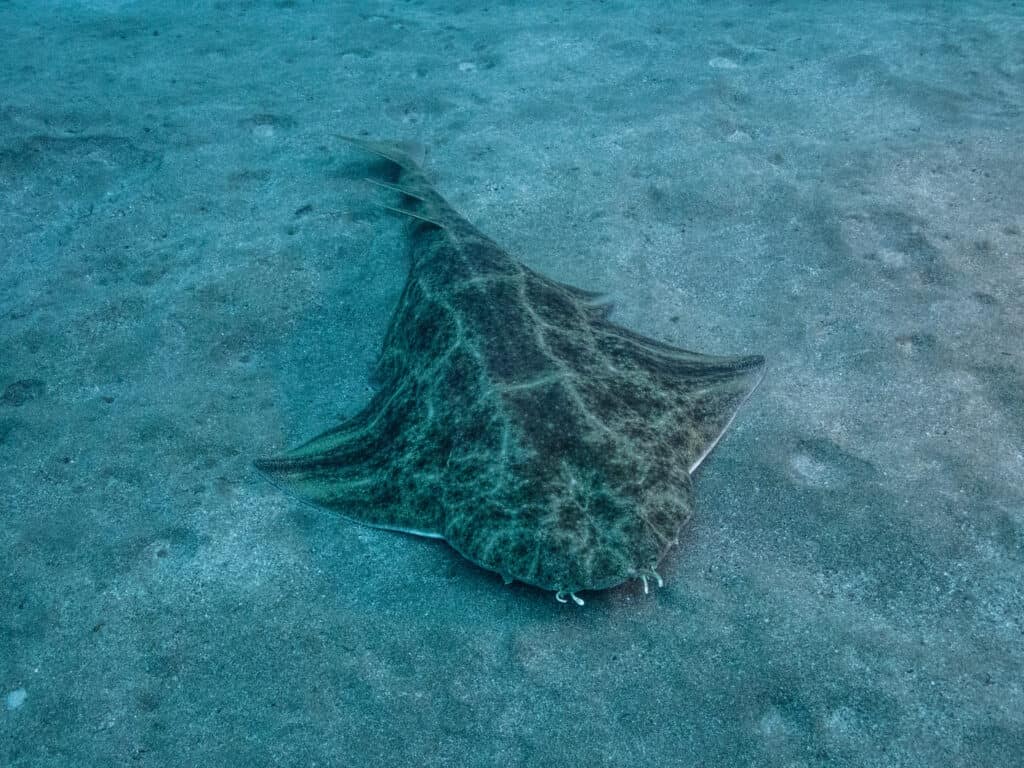
Angel sharks are harmless sharks that pose little to no threat to humans.
©LuisMiguelEstevez/Shutterstock.com
Few people would recognize an angel shark as a real shark since it looks more like a skate or a ray. There are several species of angel sharks, but none of them are very big, measuring only 3 to 7 feet long and weighing around 80 pounds at most.
The angel shark’s strategic way of feeding is similar to the leopard shark, except they bury themselves on the ocean’s bottom while they wait for prey to swim by. They have a lot of patience and can stay perfectly still while they wait for dinner to come to them.
Angel sharks primarily live in temperate waters of the world’s major ocean basins, including the east coast of North America, most of Europe, the Mediterranean Sea, and South Africa. They also live in the western Pacific, including Japan and Australia. They are harmless sharks that pose little to no threat to humans. However, since they are so good at camouflaging on the ocean floor, it’s best to keep a close eye out. Although their bites are not severe, touching or provoking an angel shark can cause them to bite as a natural defense. In addition, angel sharks are considered endangered species, so it is best to leave them alone if you see them.
4. Goblin Shark (Mitsukurina owstoni)
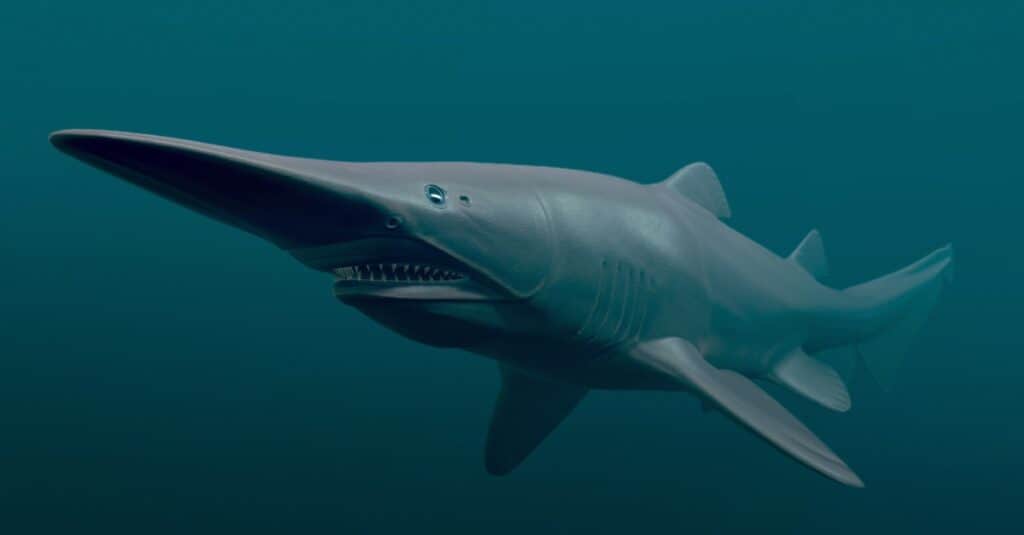
The goblin shark is scary given its size of over 12 feet.
©iStock.com/3dsam79
Someone really knew what they were doing when they named this creature. Want to have a good scare? Check these sharks out – they have a face only a mother could love. Goblin sharks get their name from their resemblance to mythical goblins in Japanese folklore. Weighing between 400 to 500 pounds and measuring 9 to 13 feet long, they’re seen mostly off Japan’s coast along continental shelves.
A few of their most recognizable physical traits are:
- A protruding spike coming out of their foreheads.
- Fang-like teeth.
- An extended flexible tail.
- Pink semi-translucent skin.
Goblin sharks can sense a fish’s electric field, and when one comes close, their jaws quickly protrude several inches, unfolding from its snout. After their prey is caught or immobilized, they retract their jaws to their normal position.
Fortunately, goblin sharks are not dangerous to humans (other than possibly causing nightmares from their appearance), but you probably don’t want to come face-to-face with one. However, these unique sharks are tough to find – they live almost a mile below sea level, so scientists don’t really know a ton about them.
5. Whitespotted Bamboo Shark (Chiloscyllium plagiosum)
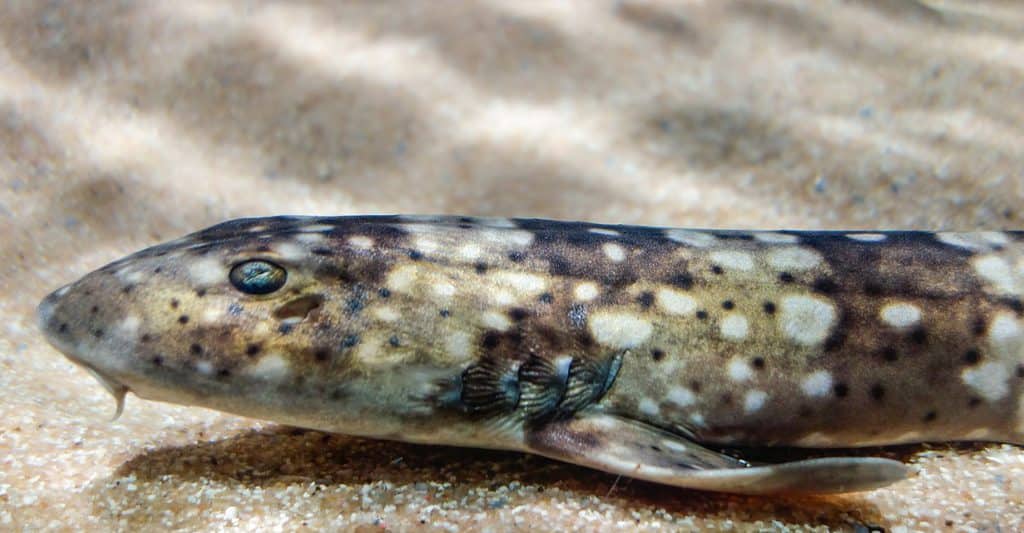
The whitespotted bamboo shark has a unique look that makes it stand out from other bamboo sharks.
©iStock.com/caio acquesta
While the whitespotted bamboo shark isn’t a threat to humans, it certainly is unique. This shark, in its own way, can actually “walk.” It moves rather slowly using its pectoral fins like legs!
Whitespotted bamboo sharks live in shallow waters west of Indonesia near coral reefs. They’re also called “longtail carpet sharks” since their tails are longer than the rest of their bodies. Small and slim, their maximum length is 37 inches. They eat prey like small fish, crustaceans, and invertebrates.
The whitespotted bamboo shark has a unique look that makes it stand out from other bamboo sharks. It is dark brown in color and has some dark stripes going across its body. In addition, it also has many irregular white or blue spots all over its body, making it easy to identify.
6. Greenland Shark (Somniosus microcephalus)
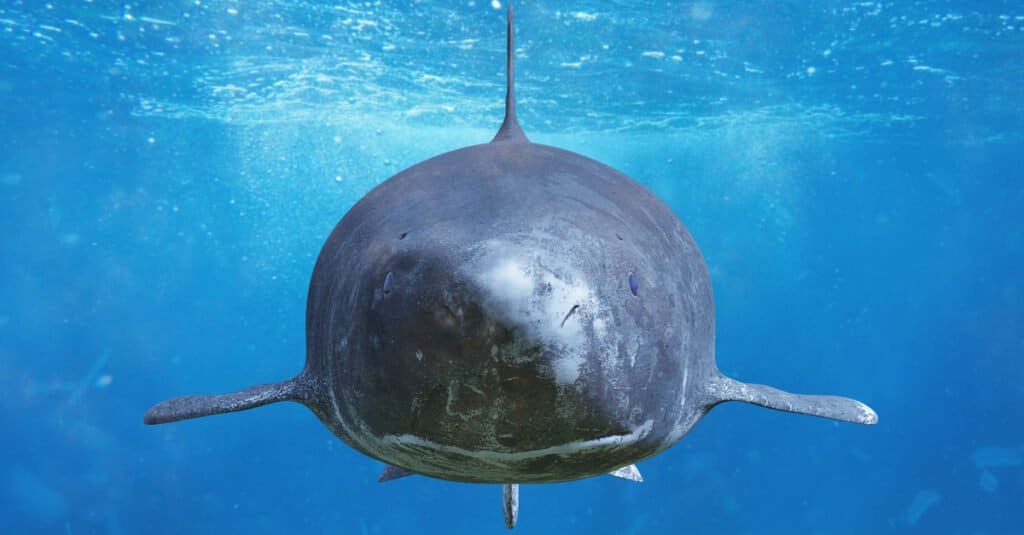
Greenland sharks can live up to 500 years.
©Dotted Yeti/Shutterstock.com
Even though parts of horses, reindeer, and moose have been found in their digestive systems, these massive sharks do not stalk or eat humans. Greenland sharks generally grow between 8 to 14 feet long and weigh between 1,500 to 2,200 pounds. They are predators, but they are not especially aggressive. They are also scavengers and have even swam beside fishing boats for leftovers.
Greenland sharks live in nearly freezing waters, so they move extremely slowly and swim at a steady pace of only .76 miles per hour! They also have very slow metabolisms to help them conserve energy. What’s especially impressive, however, is that Greenland sharks can live up to 500 years!
7. Zebra Shark (Stegostoma tigrinum)
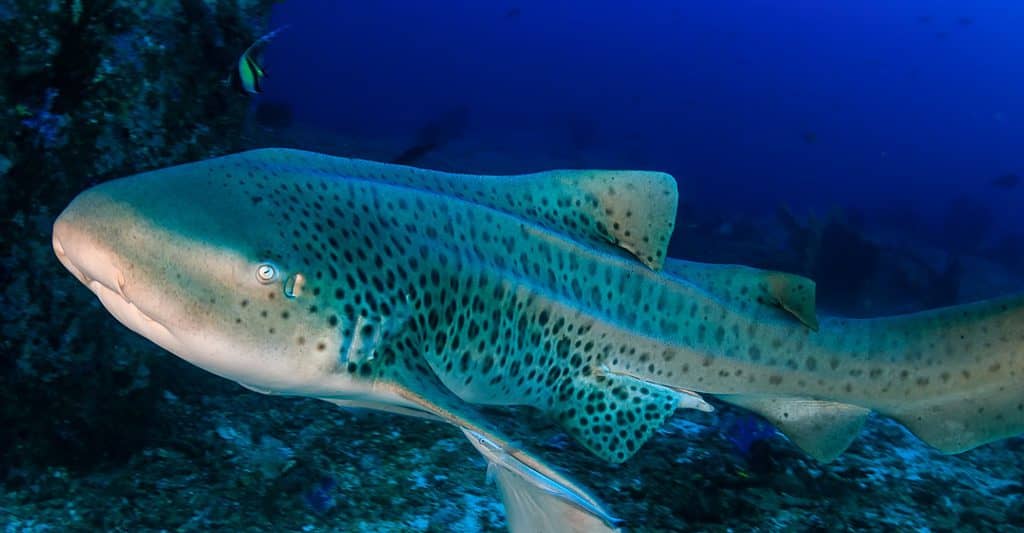
Zebra sharks prefer shallow coastal areas and coral reefs.
©iStock.com/WhitcombeRD
Incredibly docile and slow-moving, zebra sharks are typically not a threat to humans. These beautifully patterned sharks typically grow around 7 to 8 feet in length and weigh around 44 to 66 pounds. Zebra sharks at diving sites have become quite comfortable around humans and can often be seen taking food from divers’ hands and even allowing physical contact.
However, divers should exercise caution when interacting with them. Believe it or not, there have been cases where somebody attempted to pull on a zebra shark’s tail or ride them, which quite sensibly resulted in a bite to the annoying human pest.
Zebra sharks live in tropical waters throughout the Indo-Pacific region. These sharks have dark gray backs and white bellies, with distinctive stripes of yellow spots down their sides that give them their name. Zebra sharks prefer shallow coastal areas and coral reefs, where they can find plenty of food to eat, including crustaceans, mollusks, and fish.
8. Basking Shark (Cetorhinus maximus)
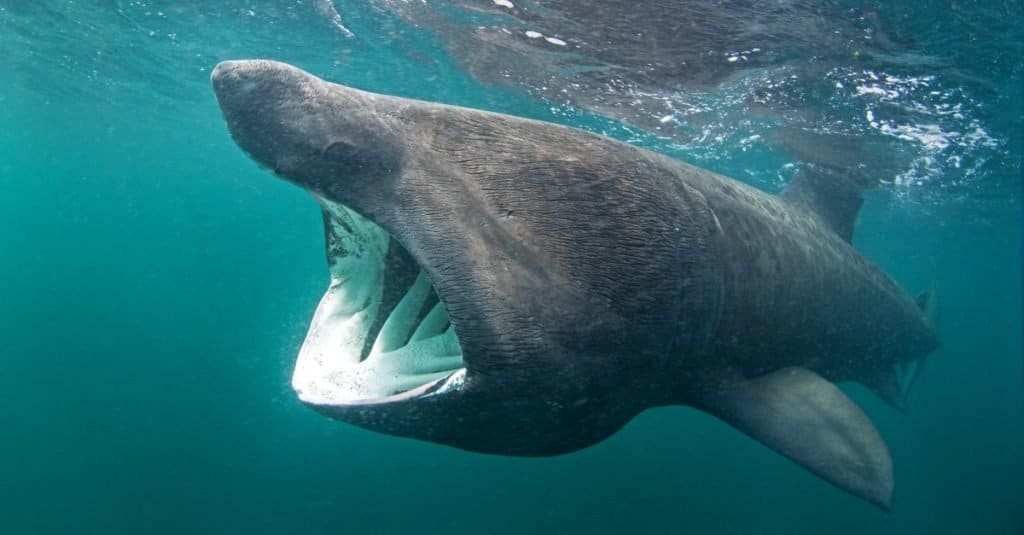
Basking sharks primarily feed on plankton and small fish.
©Martin Prochazkacz/Shutterstock.com
Another massive shark that doesn’t pose a threat is the basking shark, the second largest fish in the world. Basking sharks typically average around 18 to 26 feet long. Despite their large size, basking sharks are harmless to humans, making them a popular sighting among divers and other water-goers.
These slow-moving filter feeders swim along coastal waters and tend to move further north during warmer months of the year. They often mass migrate in large groups, although solitary individuals have also been observed.
Basking sharks primarily feed on plankton and small fish, using comb-like plates along their gills to filter out their prey. Feeding behavior often involves swimming in large circles with their mouths open, allowing them to draw in vast quantities of water before filtering it out for food.
9. Nurse Shark (Ginglymostoma cirratum)
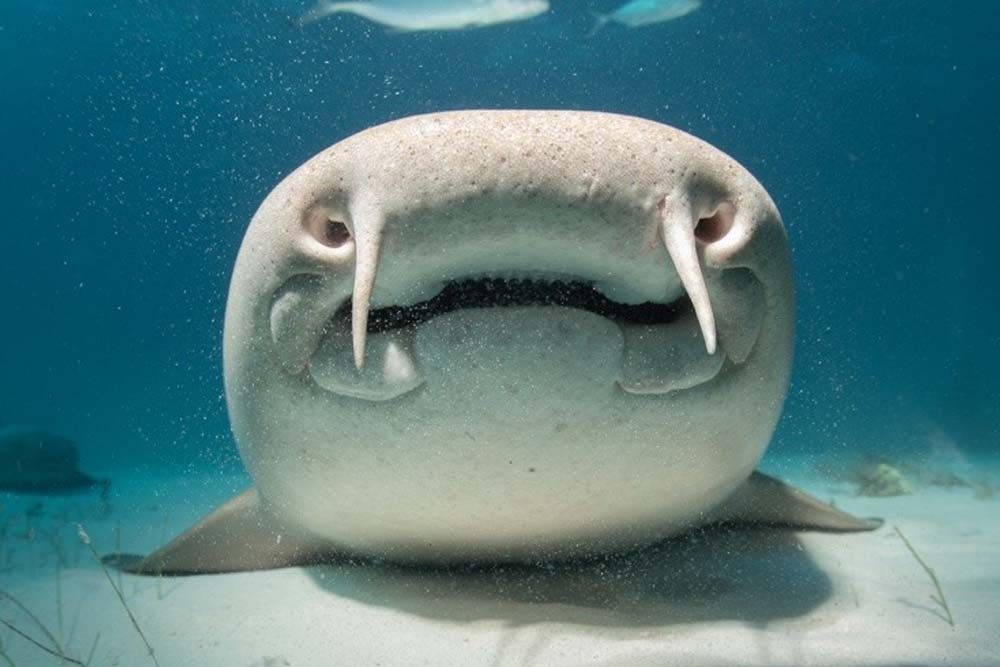
Nurse sharks feed mainly on bottom-dwelling invertebrates.
©Maui Topical Images/Shutterstock.com
Although they can reach up to 14 feet long, nurse sharks are generally considered harmless to humans. They do not display aggressive behavior toward people, although they may bite if they feel threatened. Their teeth are small and do not typically cause a great deal of damage — but it will definitely hurt!
Generally speaking though, nurse sharks pose little threat to humans and can even be frequently seen slowly swimming around divers without displaying any signs of aggression. These large sharks live primarily in shallow tropical and subtropical waters and have long, cylindrical bodies covered with small dermal denticles. They are most active at night, spending their days resting on the ocean floor or near coral reefs.
Nurse sharks feed mainly on bottom-dwelling invertebrates such as stingrays, snails, and crabs by using specialized suction-feeding abilities that enable them to easily draw out prey from the sand or other hiding places. They also occasionally eat small fish, octopus, and shrimp.
10. Sand Tiger Shark (Carcharias taurus)
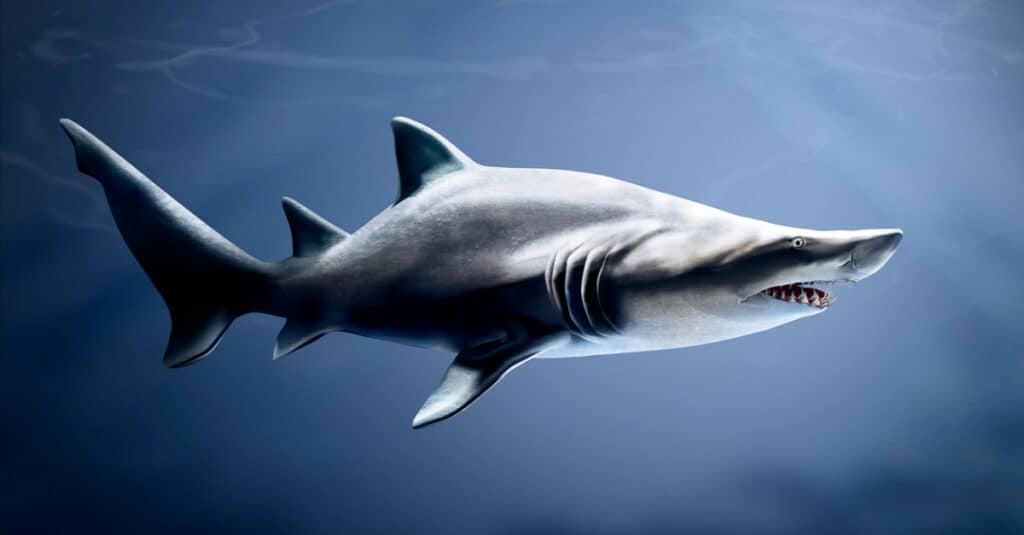
Sand
tiger
sharks are not aggressive toward humans.
©iStock.com/mirror-images
With a top-heavy body, long snout, and distinctive barred pattern, the sand tiger shark is one of the most recognizable species of sharks in the world.
These large sharks inhabit the continental shelves of subtropical and temperate oceans around the world. They feed mainly on smaller fish, squids, rays, and crustaceans.
Generally speaking, sand tiger sharks are not aggressive toward humans and will likely only attack if provoked. Attacks from these animals are typically done by smaller juveniles in the process of hunting prey and are usually accidental. However, it is best to observe caution when entering the ocean so as not to inadvertently encounter one of these large sharks.
11. Bluntnose Sixgill Shark (Hexanchus griseus)
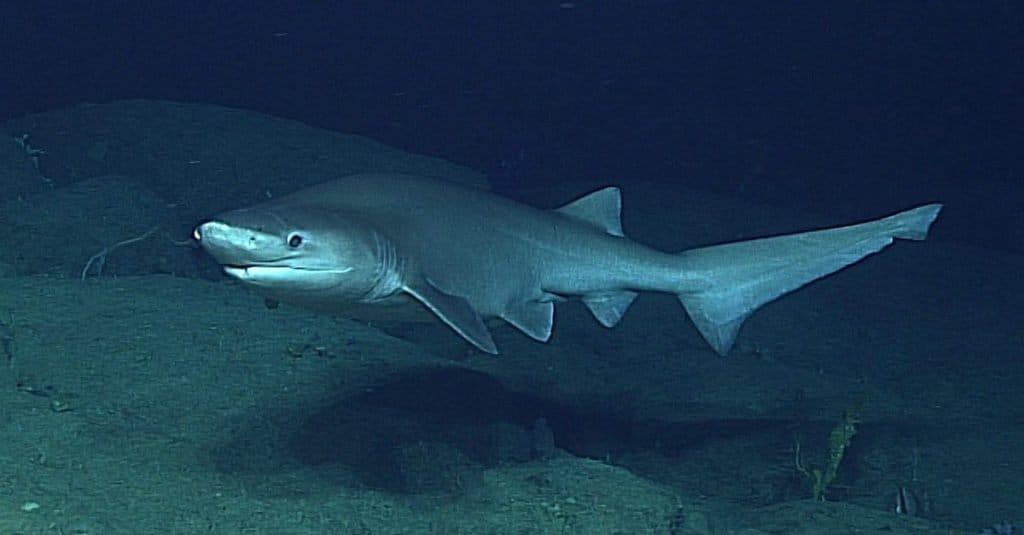
Despite their large size and formidable appearance, bluntnose sixgill sharks are not a threat to humans.
©NOAA Ocean Explorer from USA / CC BY-SA 2.0 – License
Found in temperate and tropical waters all around the world, bluntnose sixgill sharks (or cow sharks) are unique due to their multiple gill slits and distinct coloration. These sharks can grow up to 20 feet long and are renowned for their large, blunt heads.
Due to their deepwater habitats, little is known about the behavior of these animals, but they have been seen hunting bony fish as well as larger prey like seals and dolphins. Despite their large size and formidable appearance, bluntnose sixgill sharks are not a threat to humans. They are rarely seen by humans and actively avoid human contact, preferring to hunt smaller prey.
The International Shark Attack File has reported only a single incident of provocation-based human attack since the 16th century. The bluntnose sixgill shark is comfortable in the presence of divers but does not appreciate physical contact or a large human presence, and has been known to snap when touched by divers or fishers.
12. Bigeye Thresher Shark (Alopias superciliosus)

Bigeye threshers are known to feed primarily on small schooling fish.
©FtLaud/Shutterstock.com
With their distinctive long tails and wide eyes, bigeye thresher sharks have a unique look that has earned them the affection of scuba divers and ocean enthusiasts alike. These animals range in size from 10 to 13 feet long and weigh around 350 pounds.
Bigeye threshers are known to feed primarily on small schooling fish such as mackerels, herrings, and sardines. They use their long tail to herd the fish together before striking with speed and precision. Despite their reputation as top predators of the open ocean, they pose no threat to humans due to their shyness around potential predators.
13. Caribbean Reef Shark (Carcharhinus perezi)
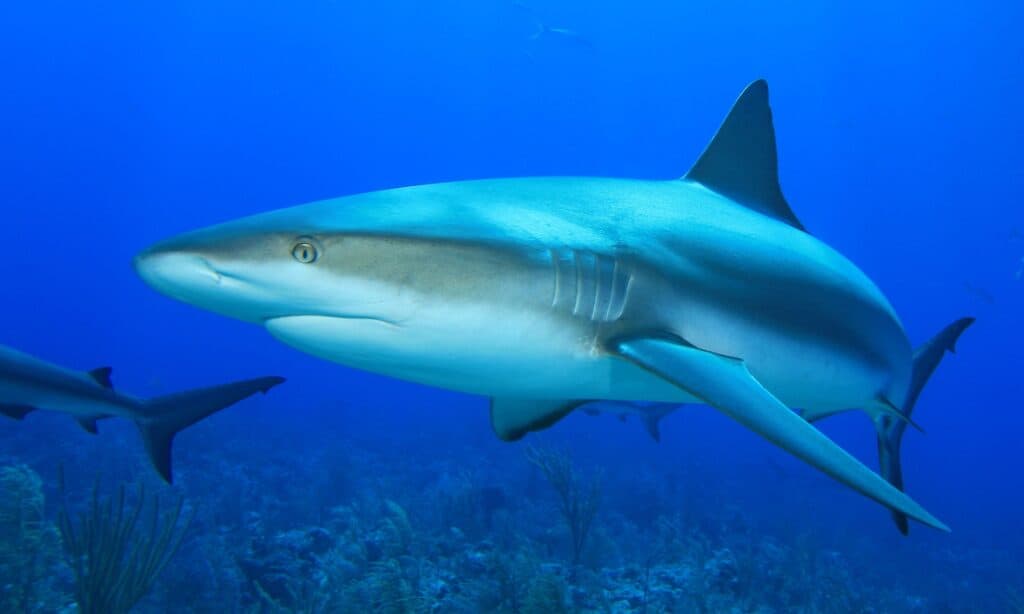
Carribean reef sharks are often mistaken for other species because they don’t have unique markings.
©iStock.com/richcarey
Sleek and charismatic predators, Caribbean reef sharks grow around 6 to 8 feet long and are easily distinguishable by their grey/brown coloration, pointed snouts, and large dorsal fins. Despite the size of these animals, they pose little threat to humans as they tend to shy away from potential predators.
Caribbean reef sharks are a species of requiem shark that inhabit tropical coral reefs throughout the Caribbean Sea. They hunt prey during the day, using their sharp senses to detect movement in the water around them. These efficient hunters feed on fish, squid, and sometimes octopus.
While there have been a handful of documented cases of Caribbean reef sharks exhibiting aggressive behavior towards humans, these incidents have usually been caused by improper handling or close proximity to the sharks rather than unprovoked attacks. If a human is in a situation where the shark is blocked off and cannot evade, the risk of attack increases, and the shark may swipe or rake against its victim, leading to lacerations.
Conclusion
Sharks, though feared by many, actually have a variety of species that pose no threat to humans. From the leopard shark to the whale shark, these magnificent creatures should be respected and admired from a safe distance in their natural ocean habitats. Our understanding of these harmless sharks has grown over the years, allowing us to appreciate them even more. By increasing knowledge and awareness of these species, we can continue to protect and conserve them for future generations.
Too often, sharks get a bad rap for being aggressive and dangerous creatures that pose a threat to humans. While it is important to be cautious when in shark-inhabited waters, we should also recognize the beauty and importance of these magnificent creatures.
While a few of these harmless sharks have had dangerous encounters with people, this is extremely rare and only when they’ve been agitated or threatened. The moral of this story is: let them be. They won’t hurt us if we don’t hurt them.
Up Next:
- 10 Cutest Sharks (One is as Big as a School Bus!)
- Shark Teeth: Everything You Need To Know
- The Top 10 Biggest Sharks in the World
- Types of Sharks: 25 Shark Species You Must Know!
The photo featured at the top of this post is © Dotted Yeti/Shutterstock.com
Sources
- Florida Museum of Natural History, Available here: https://www.floridamuseum.ufl.edu/discover-fish/species-profiles/hexanchus-griseus/
- Florida Museum of Natural History (1970) floridamuseum.ufl.edu/discover-fish/species-profiles/carcharhinus-perezi/
- Virginia Aquarium & Marine Science Center, Available here: https://www.virginiaaquarium.com/things-to-do/zebra-shark#:~:text=Zebra%20sharks%20are%20a%20docile,can%20be%20easily%20approached%20underwater
Thank you for reading! Have some feedback for us? Contact the AZ Animals editorial team.



